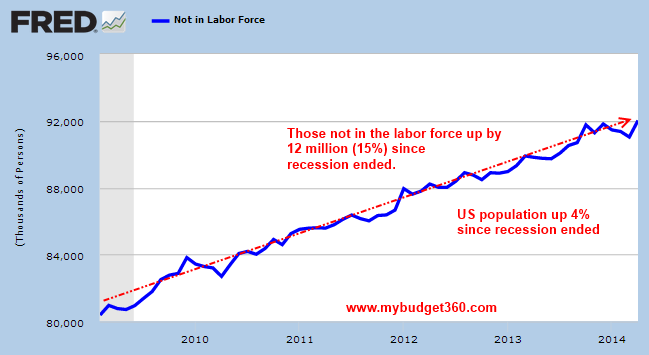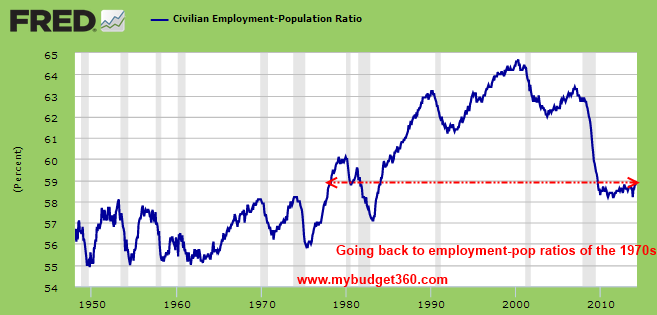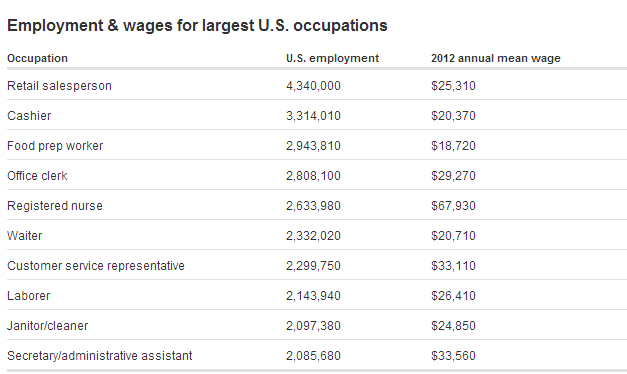Nonworking America: Those not in the labor force up by 12,000,000 since recession ended, a growth rate of 15 percent while the overall population is up 4 percent.
- 0 Comments
After World War II the U.S. saw the birth of the biggest middle class the world has ever come to know. The birth of the baby boomers and prosperity for all seemed to be the new norm. Of course, part of this was brought on by the fact that Europe, Japan, and China were in ruins or in massive social upheaval and trying to gain a foothold in the new economy. Factory jobs for a small generation paid middle class wages. More importantly, jobs were plentiful and most required little in the way of a college education. Today, that is no longer the case. The world is hyper competitive and massive banks are largely in control of policy in many nations around the globe. In the U.S. since the recession ended in 2009 we have added 12,000,000 people to a category labeled as “not in the labor force.†This is a 15 percent growth rate in this category while the overall population has increased 4 percent during this same period. Many Americans have dropped out of the labor force because they are unable to find work in this current economy and many younger Americans are simply enrolling in college at higher rates and with higher debt. We have a system that really does a poor job of measuring the economic well-being of most people. For example, GDP contracted in Q1 of 2014 yet somehow, the stock market continues to make new highs and those not in the labor force continue to expand.
Not in the labor force
Part of the growth of those not in the labor force has to do with larger demographic trends including the massive number of baby boomers hitting retirement age. Most however are ill prepared to confront the long-term prospect of living in retirement with little savings and heavily relying on Social Security. You have a larger number of older Americans working in minimum wage service sector jobs to make ends meet. Of course these are also jobs that would be normally filled by younger less skilled workers. So what ends up happening is a race to the bottom in this low-wage economy.
It is telling to see how much faster the “not in the labor force†category is growing versus the overall population rate. We have many people that have simply dropped out of the labor force. We know many younger people are camping out back at home given their poor economic prospects. Take a look at the overall rate:
More than 92 million Americans are not in the labor force (close to one-third of our population). We have a major retirement crisis looming in the wings. People simply did not save enough for the prospect of a long and potentially expensive retirement. We know inflation is already picking up in many sectors of the economy.
This larger trend has caused our civilian employment-population ratio to hit levels last seen in the 1970s before we had a large surge of females into the workforce:
According to research from the BLS this trend is expected to continue well into 2022. So we know we are going to have a larger percentage of our population simply not working yet having to live somehow. Where will this funding come from? Ideally people would have enough savings to get by but the numbers show a very different story unfortunately.
Many of the top jobs after World War II paid livable wages that allowed people to access a middle class lifestyle on one income. That is no longer the case today. The largest employment sectors in the U.S. pay just enough for basic shelter and food:
Retail sales, cashier, and food preparation round out the top three occupations in the country. Unfortunately the Great Recession destroyed many good paying jobs only to replace them with lower paying employment. Only one of the top employment fields in the country pays more than $35,000 a year (nursing) and this requires a college education.
One of the large reasons why we are seeing such a big drop in the unemployment figures is the reality that many people are simply not being considered part of the labor force. Too bad math in the real world doesn’t work in a similar fashion.
If you enjoyed this post click here to subscribe to a complete feed and stay up to date with today’s challenging market!


 If you enjoyed this post click here to subscribe to a complete feed and stay up to date with today’s challenging market!   Â
If you enjoyed this post click here to subscribe to a complete feed and stay up to date with today’s challenging market!   Â